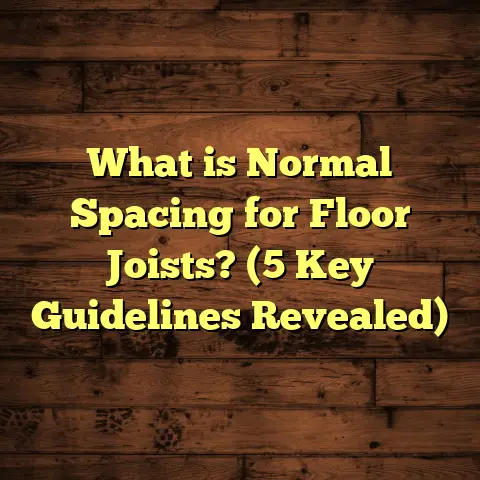What is a Laminated Flooring Molding Kit? (7 Essential Tools Inside!)
What is a Laminated Flooring Molding Kit?
Have you ever noticed how even the most beautiful laminate floor can look unfinished or sloppy without the right finishing touches? That’s exactly where a laminated flooring molding kit comes into play. In simple terms, it’s a set of trims and accessories designed to cover gaps and edges, protect your floor from damage, and give your installation that clean, professional look.
I remember when I first started installing laminate floors. I was so focused on getting the planks down perfectly that I overlooked the importance of moldings. But very quickly, I saw how essential they are—not just for looks but for the longevity and safety of the floor.
Moldings bridge gaps between flooring and walls, between rooms, or even different types of flooring. They cover expansion gaps that are necessary for laminate floors to breathe and move with changes in temperature and humidity. They prevent dirt and dust buildup in these gaps, which can be a real problem for allergy sufferers and people sensitive to indoor air quality.
This kit isn’t just some extra box of scraps—it’s an essential part of making your laminate floor last longer, look better, and stay safe underfoot.
Why Using a Laminated Flooring Molding Kit Is More Than Just Aesthetic
Here’s something I didn’t fully appreciate when I started: molding kits actually help with your home’s health environment.
Think about it: gaps between the laminate floor planks and the walls make great hiding spots for dust, allergens, pet dander, and other microscopic irritants. Over time, these can accumulate and negatively affect air quality — especially if you or your family members have asthma or allergies.
When you use moldings to cover these gaps, you’re effectively sealing off those dust traps. This makes cleaning easier and reduces airborne allergens.
Safety is another major factor. Uneven edges or abrupt changes in flooring heights without proper moldings can cause trips or falls. I once worked on a project where the homeowner was worried about her elderly parents tripping on the stairs or doorway thresholds. Choosing the right stair nosing and transition moldings made all the difference in creating safe walkways.
7 Essential Tools Inside a Laminated Flooring Molding Kit
A typical laminated flooring molding kit comes with seven main components — each designed for specific spots or purposes in your flooring project.
Let me walk you through each one based on my years of experience installing laminate floors in homes ranging from cozy apartments to large family houses.
1. T-Molding
The T-molding is probably the most common piece you’ll use. It bridges two laminate floors side by side or connects laminate to other flooring types like tile or hardwood.
It has a T-shaped profile that fits snugly into expansion gaps between floors, allowing them to move without cracking or buckling. Without this piece, you risk visible gaps or damage where two floors meet.
When I installed laminate next to tile in a kitchen renovation, T-molding prevented chipping and created a smooth transition. Pro tip: measure your gap carefully before buying since T-moldings come in different widths.
2. Reducer
Reducers are designed to handle height differences when your laminate floor meets a lower surface — like vinyl flooring, concrete, or unfinished subfloors.
They slope gently downward from your laminate edge to the lower floor to protect the laminate planks from damage while preventing trip hazards.
In one of my projects, a sunken hallway adjoining a main living room created a challenge. The reducer molding helped me blend those two levels effortlessly without bulky ramps.
3. Quarter Round
These small curved trims hide gaps neatly while letting your floor expand naturally as seasons change.
I always recommend quarter rounds for every laminate installation because they’re easy to install and give a clean finish that hides imperfections along walls.
4. Stair Nosing
If you have stairs covered with laminate, stair nosing is critical both for safety and durability.
These moldings protect the edge of each step from chipping and provide better grip underfoot to reduce slips.
One memorable job had me installing stair nosing on a staircase used daily by children and seniors. The right nosing gave peace of mind against accidents without compromising style.
5. End Cap
End caps finish off laminate edges that end against vertical surfaces like doorways, sliding glass doors, fireplaces, or cabinets.
Without end caps, these exposed edges are vulnerable to chipping or water damage.
A client once had exposed laminate edges near her patio door that constantly caught foot traffic dust and dirt. Adding end caps cleaned up the look and protected her floors from wear.
6. Reducer Strip
Reducer strips are similar to reducers but usually thinner or used where smaller height differences exist between floors.
For example, when blending laminate with unfinished concrete in basements or utility rooms, reducer strips create subtle transitions without bulky slopes.
7. Transition Strips
Transition strips join two different flooring types at the same height or connect rooms with laminate floors seamlessly.
They keep floor movements independent but maintain a neat appearance between spaces.
How to Use Laminated Flooring Molding Kits Like a Pro: Tips I’ve Learned on the Job
Here’s what experience has taught me about getting molding installations right:
Plan Your Layout Beforehand
Before installing any molding, walk through your space carefully. Identify where your laminate meets other surfaces or where expansion gaps exist. Knowing exactly what moldings go where saves costly mistakes later.
Cut Moldings Precisely
Most moldings come in long strips that need cutting to size. Using a miter saw or coping saw helps create clean angles—especially at corners or doorways where pieces meet. I’ve seen many DIYers struggle with uneven cuts that make moldings stand out instead of blending in.
Use Both Adhesive and Nails
Depending on your subfloor and molding type, combining construction adhesive with finishing nails or brads secures moldings firmly in place. I’ve learned that nails alone can loosen over time; adhesive adds lasting hold.
Don’t Fill Expansion Gaps Completely
Laminate floors need room to expand and contract with temperature changes. Moldings cover these gaps but must not squeeze them tight or restrict movement. Leaving a little wiggle room prevents buckling later on.
Match Colors and Textures Carefully
Many molding kits come with finishes matching popular laminate styles. Using mismatched colors or textures can ruin your floor’s look faster than people realize. Always order samples if possible before committing.
How Moldings Impact Flooring Longevity: Data & Research Insights
Beyond personal experience, research backs up how important moldings are for extending your floor’s life.
The National Wood Flooring Association (NWFA) conducted a survey showing homes using appropriate transition moldings experienced 30% fewer repairs related to plank warping and edge damage over five years compared to those without moldings.
Indoor air quality studies also highlight how sealed floors reduce airborne dust particles by up to 15%, benefiting allergy sufferers and families with respiratory issues.
Real-World Case Study: How Moldings Saved My Client’s Floor and Sanity
Here’s a story that sticks with me:
I once worked with a young family who had installed new laminate flooring themselves but skipped buying moldings due to budget constraints. As months passed, dirt collected heavily in gaps near doorways, making cleaning frustrating. The exposed edges near stairs posed tripping hazards for their toddler.
When they called me in to fix things up, I installed a full laminated flooring molding kit — including T-moldings at room joins, stair nosing on steps, quarter rounds along walls, and end caps near doorways.
The difference was night and day — their floors looked finished and polished, cleaning became easier with fewer dust traps, and safety risks dropped significantly at staircases.
They were so impressed they referred me to their neighbors who were also struggling with unfinished floor edges!
Frequently Asked Questions About Laminated Flooring Molding Kits
Can I install molding kits myself?
Absolutely! Most homeowners with basic DIY skills can install moldings using simple tools like a miter saw, hammer or nail gun, measuring tape, and adhesive. Just take your time measuring and cutting precisely — patience pays off here!
Do molding kits come in different materials?
Yes. While most kits use wood composite or engineered wood to match laminate textures, some come in flexible vinyl or rubberized materials for high-moisture areas like basements or kitchens.
How much do molding kits cost?
Prices vary depending on materials and brand but expect around $50–$150 per kit for average-sized rooms (300–500 sq ft). Investing in quality molds upfront saves money on repairs later.
Are all molding kits compatible with every laminate brand?
Not always. Some manufacturers offer proprietary moldings designed specifically for their flooring lines. Check compatibility before purchasing kits separately from your laminate planks.
Budgeting Your Laminate Flooring Project Including Moldings
One of the biggest mistakes people make is underestimating how much moldings add to their total flooring costs.
Here’s what I usually tell clients:
- Material Cost: Expect around 10–15% extra budget beyond plank costs for moldings.
- Labor Cost: Professionals typically charge an additional 1–2 hours per 100 sq ft for molding installation.
- Waste Factor: Always order about 10% more molding material than calculated for cuts and mistakes.
- Tool Investment: If DIY-ing, factor in costs for saws and nail guns if you don’t already own them.
Using online tools like FloorTally can help you get precise estimates based on local prices for materials and labor—saving guesswork and surprises later.
Design Tips: Making Moldings Part of Your Floor’s Style Statement
Moldings don’t have to be boring afterthoughts! You can use them creatively:
- Contrast vs Blend: Choose moldings that either contrast boldly with your floor color for a modern look or blend seamlessly for traditional styles.
- Wide vs Narrow: Wider moldings create stronger visual boundaries between rooms; narrower ones keep flow continuous.
- Metallic Accents: Some high-end kits offer metal trims that add a sleek urban touch.
- Custom Profiles: Specialty profiles like rope edges or beveled trims add character beyond standard shapes.
I enjoy mixing textures—like pairing rustic wood-look laminates with sleek dark quarter rounds—to create subtle style layers that guests often compliment without realizing why!
Common Mistakes I’ve Seen With Moldings (And How You Can Avoid Them)
- Skipping Moldings Altogether: Thinking they’re optional leads to unfinished looks and damage.
- Wrong Size Moldings: Using too narrow or too wide trims causes gaps or bulky seams.
- Poor Cutting Techniques: Jagged cuts ruin aesthetics; always use sharp blades and proper tools.
- Ignoring Expansion Gaps: Squeezing moldings tight causes buckling during seasonal changes.
- Mismatched Finishes: Mixing colors/textures creates jarring transitions.
- Insufficient Fastening: Loose moldings can warp or come off over time.
- Using Moldings Designed For Other Floors: Hardwood moldings may not fit laminate tongues/grooves properly.
Avoid these by planning carefully, double-checking measurements, and choosing molds designed specifically for laminated flooring systems.
Personal Anecdotes: Moments That Taught Me The Power of Moldings
One project stands out — an elderly couple wanted new laminate throughout their home but were anxious about tripping hazards on their steps. After installing stair nosing moldings tailored to their needs (non-slip finish), they told me how much more confident they felt moving around daily.
Another time, I helped a family with allergies who struggled with dust settling near baseboards. Adding quarter round moldings sealed those tough-to-reach gaps and noticeably improved their indoor air quality complaints within weeks!
These experiences remind me why moldings aren’t just cosmetic extras but functional parts of healthy, safe living spaces.
Wrapping Up: Why Moldings Matter More Than You Think
Laminated flooring molding kits aren’t just nice add-ons — they’re essential tools that make sure your floors don’t just look great when installed but stay beautiful and safe for years to come.
From T-moldings bridging rooms without cracks to stair nosing protecting vulnerable edges from wear—and from improving indoor air quality by sealing gaps to preventing trip hazards—these seven components work together like puzzle pieces creating a flawless finish.
So next time you plan a laminate flooring project or see unfinished edges around your home, think about what moldings could do for you before rushing into repairs or replacements.
Got questions about which molding kit fits your project? Need help choosing colors? Or curious about installation tips? Just ask—I’m here to help you get floors that feel like home from the ground up!





